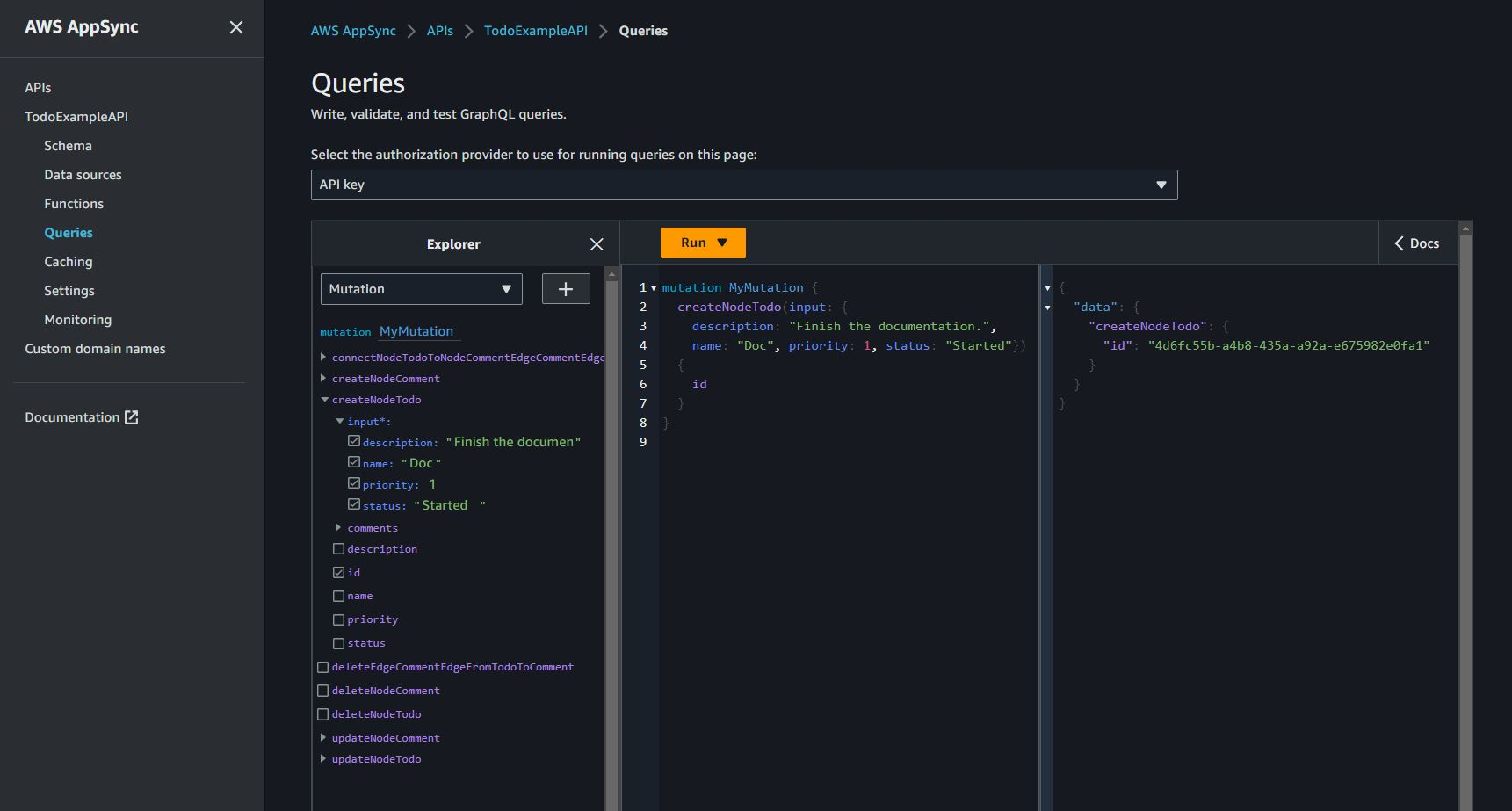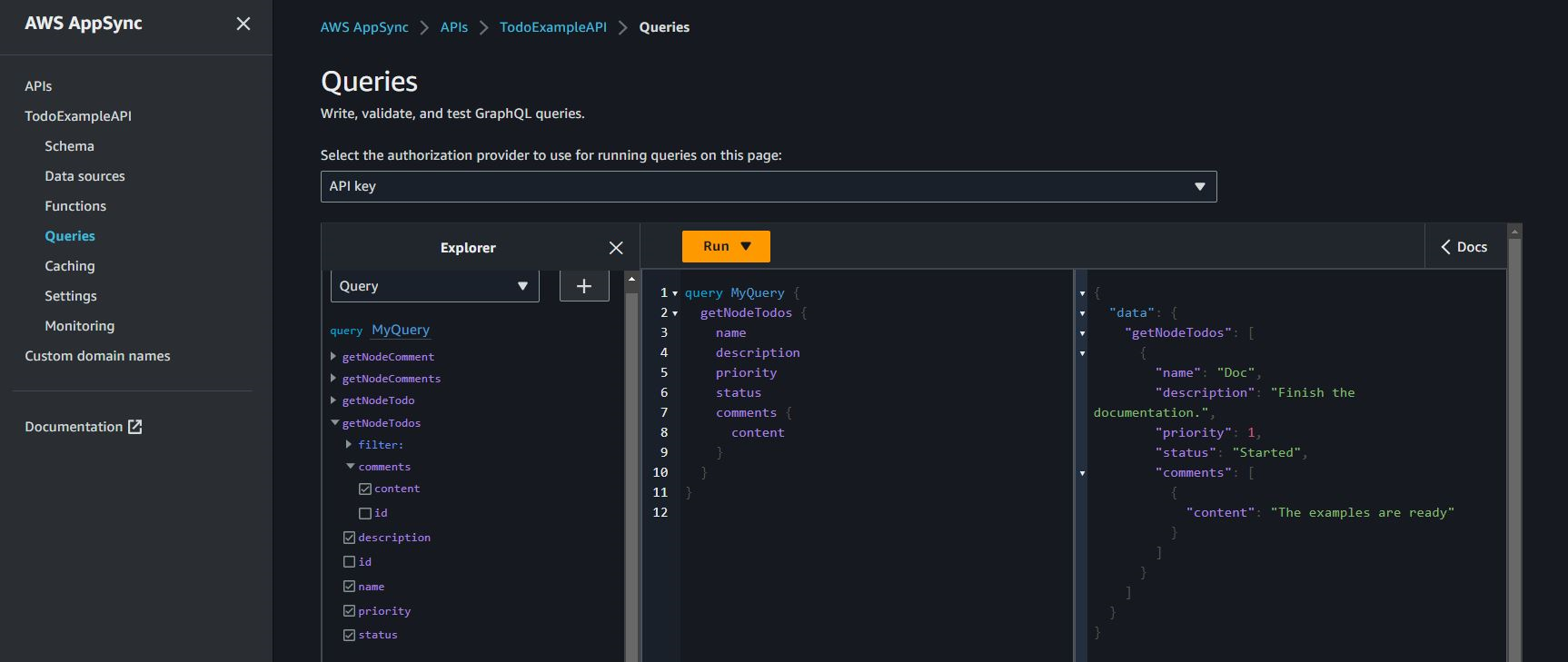Starting from a GraphQL schema with no directives
You can start from an empty Neptune database and use a GraphQL schema with no directives to create the data and query it. The command below automatically creates Amazon resources to do this:
neptune-for-graphql \ --input-schema-file(your GraphQL schema file)--create-update-aws-pipeline \ --create-update-aws-pipeline-name(name for your new GraphQL API)\ --create-update-aws-pipeline-neptune-endpoint(your Neptune database endpoint):(port number)\ --output-resolver-query-https
The GraphQL schema file must include the GraphQL schema types, as shown in the TODO example below. The utility analyzes your schema and creates an extended version based on your types. It adds queries and mutations for the nodes stored in the graph database, and if your schema has nested types, it adds relationships between the types stored as edges in the database.
The utility creates an AppSync GraphQL API, and all the Amazon resources required. These include a pair of IAM roles and a Lambda function that contains the GraphQL resolver code. When the command completes, you can find a new GraphQL API with the name you specified in the AppSync console. To test it, use Queries in the AppSync menu.
The example below illustrates how this works:
Todo example, starting from a GraphQL schema with no directives
In this example we start from a Todo GraphQL schema with no directives, which you
can find in the ???samples??? directory. It includes
these two types:
type Todo { name: String description: String priority: Int status: String comments: [Comment] } type Comment { content: String }
This command processes the Todo schema and an endpoint of an empty Neptune database to create a GraphQL API in Amazon AppSync:
neptune-for-graphql / --input-schema-file ./samples/todo.schema.graphql \ --create-update-aws-pipeline \ --create-update-aws-pipeline-name TodoExample \ --create-update-aws-pipeline-neptune-endpoint(empty Neptune database endpoint):(port number)\ --output-resolver-query-https
The utility creates a new file in the output folder called TodoExample.source.graphql,
and the GraphQL API in AppSync. The utility infers the following:
In the Todo type it added
@relationshipfor a new CommentEdge type. This instructs the resolver to connect Todo to Comment using a graph database edge called CommentEdge.It added a new input called TodoInput to help the queries and mutations.
It added two queries for each type (Todo, Comment): one to retrieve a single type using an
idor any of the type fields listed in the input, and the other to retrieve multiple values, filtered using the input for that type.It added three mutations for each type: create, update and delete. The type to delete is specified using an
idor the input for that type. These mutations affect the data stored in the Neptune database.It added two mutations for connections: connect and delete. They take as input the node ids of the from and to vertices used by Neptune and the connection are edges in the database.
The resolver recognizes the queries and mutations by their names, but you can customize them as shown below.
Here is the content of the TodoExample.source.graphql file:
type Todo { _id: ID! @id name: String description: String priority: Int status: String comments(filter: CommentInput, options: Options): [Comment] @relationship(type: "CommentEdge", direction: OUT) bestComment: Comment @relationship(type: "CommentEdge", direction: OUT) commentEdge: CommentEdge } type Comment { _id: ID! @id content: String } input Options { limit: Int } input TodoInput { _id: ID @id name: String description: String priority: Int status: String } type CommentEdge { _id: ID! @id } input CommentInput { _id: ID @id content: String } input Options { limit: Int } type Query { getNodeTodo(filter: TodoInput, options: Options): Todo getNodeTodos(filter: TodoInput): [Todo] getNodeComment(filter: CommentInput, options: Options): Comment getNodeComments(filter: CommentInput): [Comment] } type Mutation { createNodeTodo(input: TodoInput!): Todo updateNodeTodo(input: TodoInput!): Todo deleteNodeTodo(_id: ID!): Boolean connectNodeTodoToNodeCommentEdgeCommentEdge(from_id: ID!, to_id: ID!): CommentEdge deleteEdgeCommentEdgeFromTodoToComment(from_id: ID!, to_id: ID!): Boolean createNodeComment(input: CommentInput!): Comment updateNodeComment(input: CommentInput!): Comment deleteNodeComment(_id: ID!): Boolean } schema { query: Query mutation: Mutation }
Now you can create and query data. Here is a snapshot of the AppSync
Queries console used to test the new GraphQL API, named
TodoExampleAPI in this case. In the middle window, the Explorer
shows you a list of queries and mutations from which you can pick a query,
the input parameters, and the return fields. This screenshot shows the
the creation of a Todo node type using the createNodeTodo
mutation:

This screenshot shows querying all Todo nodes using the getNodeTodos
query:

After having created a Comment using createNodeComment, you can use
the connectNodeTodoToNodeCommentEdgeCommentEdge mutation to connect them
by specifying their ids. Here is a nested query to retrieve Todos and their attached
comments:

If you want to make changes to the TodoExample.source.graphql file as
described in Working with directives,
you can then use the edited schema as input and run the utility again. The utility
will then modify the GraphQL API accordingly.